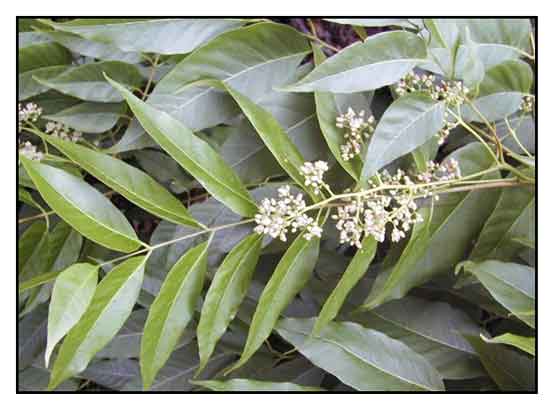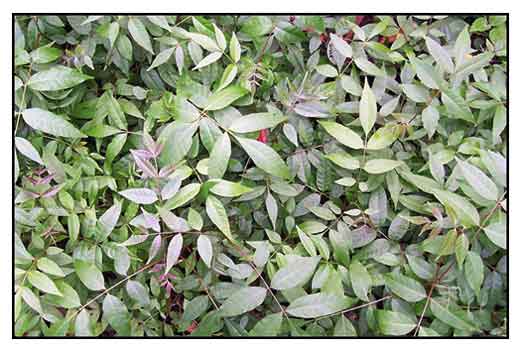 Botany Botany
Toona ciliata is a fast growing medium-sized to large deciduous tree with a rounded, spreading, occasionally dense crown, growing to a height of 20 to 35 meters, occasionally as high as 50 to 60 meters. The trunk can be clean for 9 to 22 meters with a diameter of 180 to 300 centimeters. Bark is brown to grey. Leaves are 15 to 35 centimeters long, usually paripinnate, sometimes with a terminal leaflet, asymmetric base, entire margins, glabrous, with acuminate apex. Petals are white, 5 to 6 millimeters long. Seed is encapsulated in an ellipsoid capsule, 10 to 20 millimeters lone, 6 to 8 millimeters in diameter, winged at both ends.
Distribution
- Found in Philippines, China, Myanmar, Thailand, Cambodia, Laos, Vietnam, Malaysia, Indonesia, New Guinea, Australia.
- Common to abundant in shade or open habitats, forests mountainsides, near rivers and streams.
 Constituents Constituents
- Phytochemical screening of various solvent extracts of leaves and flowers yielded carbohydrates, proteins, phytosterols, flavonoids, glycosides, tannins, and phenolic compounds. (see study below) (6)
- Study of 95% ethanol extract of leaves and stems of T. ciliata var. pubescens yielded 23 compounds identified as siderin (1), 4, 6, 7-trimethoxy-5-methylcoumarin (2), isoscopoletin (3), scopoletin (4), 6, 7-dimethoxycoumarin (5), 7-hydroxy-6, 8-dime-thoxycoumarin (6), dehydrodiconiferyl alcohol (7), (−)-lariciresinol (8), thero-2, 3-bis-(4-hydroxy-3-methoxypheyl)-3-methoxy-propanol (9), cycloeucalenol (10), 8(14), 15-isopimaradiene-2, 3, 19-triol (11), 3S, 5R-dihydroxy-6R, 7-megstigmadien-9-one (12), (−)-loliolide (13), (+)-catechin (14), dimethyl malate (15), diisobutyl phthalate (16), dibutyl phthalate (17), 1, 3, 5-trimethoxybenzene (18), syringic acid (19), syringaldehyde (20), vanillic acid (21), vanillin (22), and 3, 3′, 5, 5′-tetra-tert-butyl-2, 2′-dihydroxybiphenyl (23). (8)
- Leaves yield aromatic compounds like coumarin glycoside, tannins, flavonoids, phenolic compounds, triterpenoids and sterols. (8)
- Study of leaves and twigs yielded three new norlimonoids (1-3), two new tirucallane-type triterpenoids (4 and 5), and a new pimaradiene-type diterpenoid (6), along with two known limonoids and eight known tirucallane-type triterpenoids.
(see study below) (10)
- Study of stem barks of Toona ciliata var. henryi yielded toonaciliatavarins A-H )1-8), including three new protolimonoids (1-3), two new tirucallane-type triterpenoids (4 and 5) and three new tetranortriterpenoids (6-8), and 10 known compounds. (see study below) (11)
- Study of T. ciliata for chemical constituents yielded seven compounds from petrol and chloroform extracts identified as as 3-Acetoxy-17-furan-3-yl-1-hydroxy-1, 4, 4, 10, 13-pentamethyl-12-oxo-tetradecahydro-16, 20-dioxa-cyclopropa [14, 15] cyclopenta [alpha] phenanthrene-7-carboxylic acid methyl ester (1), beta-sitosterol (2), stigmasterol (3), n-C35H72 (4), palmitinic acid (5), n-C20H42 (6), 3-(3-Propyl-[1,1',3',1"]tercyclohexan-3"-yl)-propan-1-ol (7). (12)
- Study of stem bark of Toona ciliata var. pubescens yielded six new tirucallane protolimonoids, toonapubescins A-F (1-6), one new rearranged tirucallane protolimonoid, toonapubescin G (7), and two two 21,22,12-trinorapotirucallane limonoids, toonapubesic acids A and B (8 and 9), along with five known tirucallane protolimonoids (10-14) and one known apotirucallane limonoid (15). (see study below) (18)
- GC-<S analysis of essential oil yielded main components of estragole (6.16%), ß-elemene (24.91%), ß-cubebene (1421%), and y-elemene (8.05%). (see study below) (20)
Properties
Studies have suggest antimicrobial, antidiabetic, antihyperlipidemic, antioxidant, anti-inflammatory, analgesic, cytotoxic, anthelmintic. antiulcer, properties.
Parts used
Bark, flowers, roots, seeds.
Uses
Edibility
- Leaves are cooked.
Folkloric
- Bark is considered astringent, febrifuge, tonic, and antiperiodic. Used to treat dysentery and wounds. Resinous gum from bark used to treat boils. (4).
- Flowers used as emenagogue. (4)
- In Tanzania, roots used for treatment of wounds. (17)
- In traditional Chinese medicine, seeds used for treatment of diarrhea, dysentery, and ringworm. (8)
Others
- Dye: Flowers yield a red coloring matter and a sulphur-colored dye Cotton and woolen fabrics can be dyed yellow by mere immersion in boiling extract of flowers.
- Tannin: Bark yield tannin.
- Fruit yields an aromatic oil.
- Wood used for shitake mushroom culture.
- Wood: Wood is hard and durable; used for cabinetry. It is used extensively for furniture, wood paneling and construction; for making cigar-boxes, decorative plywood, mouldings, etc.
Wood of this species highly regarded in the manufacture of light-weight racing boats and dinghies. (4)
Studies
• Antioxidant / Antiglycation / Hypoglycemic / Cytotoxicity: Extracts of T. ciliata and Schkuhria pinnata were evaluated for potential antiglycation and hypoglycemic effect. Cytotoxicity profiles of extracts were determined using MTT assay on C2C12 cells. T. ciliate methanol extract showed highest percentage yield (20.83%) and high total phenols and flavanoids compared to S pinnata extracts. An acetone extract of T. ciliata showed good activity to DPPH scavenging and FRAP assays with EC50 values of 1.90 mg/ml and 5.26 mg/ml, respectively. The hexane extract of T. ciliata was less toxic to C2C12 cells with CC50 value of 402.16µg/ml. Overall, the hexane extract of S. pinnata showed highest antiglycation potential. Hexane extract of S. pinnata showed most potent glucose uptake ability. (3)
• Antibacterial / Root, Leaf and Stem: Study evaluated the antibacterial activity of various extracts of T. ciliata stem, leaf, and root powder against ten different randomly selected bacteria by disc diffusion. A methanol extract
showed strong activity against all test bacteria with MIC values ranging from 10 mg/ml to 35 mg/ml. (5)
• Antimicrobial / Antioxidant / Leaf and Flowers: Study evaluated various solvent extracts (petroleum ether, chloroform, ethyl acetate and methanol) of T. ciliata leaf and flower for phytochemical constituents, antimicrobial and antioxidant activities. Ethyl acetate and methanol extracts showed moderate activity against test phytopathogenic bacteria compared to tetracycline. Moderate activity was seen against Proteus mirabilis and least against K. pneumonia, S. typhi, and S. aureus. Methanol extract exhibited significant antifungal activity was seen against Microsporum canis with MIC of 1.25 mg/ml compared to miconazole. All extracts showed significant DPPH and ABTS radical scavenging activity in comparison with BHT. (see constituents above) (6)
• Antidiabetic / Leaves: Leaves have been shown to have beneficial effect on decreasing blood glucose levels and hyperlipidemia. Hypoglycemic activity have been attributed to flavonoids. (8)
• Anti-Ulcer / Heartwood: Study showed the anti-ulcer activity of ethanolic extract of heartwood in aspirin plus pylorus ligation induced gastric ulcer. There was significant reduction in gastric volume, free acidity, total acidity, and ulcer score. Activity may be due to terpenoids and steroids. (8)
• Anti-Inflammatory / Antioxidant / Leaves: Study evaluated the anti-inflammatory, antioxidant activities and polyphenols of leaves of T. ciliata grown in Bangladesh. At dose of 400 mg/kg extract showed anti-inflammatory activity )p<0.01) in a rat model of carrageenan and histamine-induced paw edema. In ABTS scavenging assay, IC50 was significant (5.50 µg/ml) compared to ascorbic acid (12.01 µg/ml). Total antioxidant capacity, total phenolic and flavonoid content were 357.1 mg/g ascorbic acid, 239.2 mg/g gallic acid, and 98.36 ,mg/g quercetin equivalent, respectively. (9)
• Toonaciliatin M / Antifungal Terpenoid / / Leaves and Twigs: Study of leaves and twigs yielded three new norlimonoids (1-3), two new tirucallane-type triterpenoids (4 and 5), and a new pimaradiene-type diterpenoid (6), along with two known limonoids and eight known tirucallane-type triterpenoids. Compound 6, Toonaciliatin M, showed moderate antifungal activity against Trichophyton rubrum with an MIC of 12.5 µg/ml. (10)
• Cytotoxic / Anti-Inflammatory / Stem Bark: Study of stem barks of Toona ciliata var. henryi yielded toonaciliatavarins A-H )1-8), including three new protolimonoids (1-3), two new tirucallane-type triterpenoids (4 and 5) and three new tetranortriterpenoids (6-8), and 10 known compounds. The new isolated were evaluated for cytotoxicity using six human cancer cell lines and for inhibitory effects on lipopolysaccharide-induced nitric oxide production in RAW264.7 cells. Compounds 4 and 5 showed moderate cytotoxicities, and the protolimonoids 1-3 exhibited marked inhibitory effects on LPS-stimulated NO production. (11)
• Analgesic / Anti-Inflammatory / Leaves: Study evaluated the analgesic and anti-inflammatory effects of leaves of T. ciliata in laboratory animals. Ethanol extract of leaves was evaluated for acute effect on analgesia by hot-plate test in mice and for inflammation using carrageenan-induced rat paw edema in rats. Results showed significant inhibition (p<0.0g) of paw volume by 43.33% at dose of 500 mg/kbw and dose-dependent increase in reaction time in hot plate test. (13)
• Antitumor / Cytotoxicity / Siderin / Stem Bark: Study evaluated Toona ciliata stem bark for cytotoxicity and antitumor activity. Crude extracts and a major isolate, siderin, exhibited significant cytotoxicity in brine shrimp lethality bioassay, and mild to moderate antitumor activity in potato disc bioassay. Results were compared to vincristine sulphate. (14)
• Antidiabetic / Leaves: Study investigated the antihyperglycemic activity of leaves of T. ciliata hydroalcoholic extract in STZ-induced diabetic rats. At extract doses of 0.2 and 0.4 g/kbw, results showed a significant decrease in blood glucose, serum cholesterol and triglyceride levels, while total protein and HDL-C were increased compared to control. (15)
• Antimicrobial Gel Formulation / Toona ciliata and Ficus bengalensis / Synergism / Leaves and Stem Bark: Study evaluated the antimicrobial property of a gel formulation of T. ciliata leaves and F. bengalensis stem bark. Antibacterial activity was observed against S. aureus, B. subtilis, P. aeruginosa and antifungal activity against C. albicans. Of various formulations, ratio 3.7 showed synergistic effect. (16)
• Protolimoids and Norlimonoids / Protection against CDC25B and H2)2 Cell Damage / Stem Bark: Study of stem bark of T. ciliata yielded protolimonoids and norlimonoids. Toonapubescin G (7) showed promising activity against CDC25B with IC50 of 21 µM, while compound 8a showed significant cell protecting activity against H2O2-induced SH-SY5Y cell damage with 11.5% increased in cell viability. (see constituents above) (18)
• Anthelmintic / Leaves: Study evaluated the anthelmintic activity of ethanolic extract of leaves of Toona ciliata against Indian earthworm Pheretima posthuma. Results showed significant anthelmintic activity (p<0.001) although less potent than standard drug Albendazole. (19)
• Antidepressant / Essential Oil: Study
investigated the antidepressant effect of essential oil isolated from T. ciliata. Antidepressive effect were evaluated by immobility time in forced swimming test (FST), tail suspending test (TST), and open field test (OFT). Results showed the essential oil significantly reduced FST and TST without accompanying changes in ambulation when assessed by OFT. The EO also increased dopamine, norepinephrine, 5-hydroxytryptamine and BDNF(braiin-derived neurotrophic factor) in the hippocampus of CMS rats. Results suggest potential for the essential oil for curing depressive disorders. (20)
• Anti-Dengue: Review reports on the anti-dengue activity of selected plant species from Meliaceae family: Toona ciliata and Melia azadirachia, which have shown antiviral and antiparasitic activity due secondary metabolites such as limonoids, polyphenols, and tannins. (21)
Availability
Wild-crafted.
|

![]()




 Constituents
Constituents